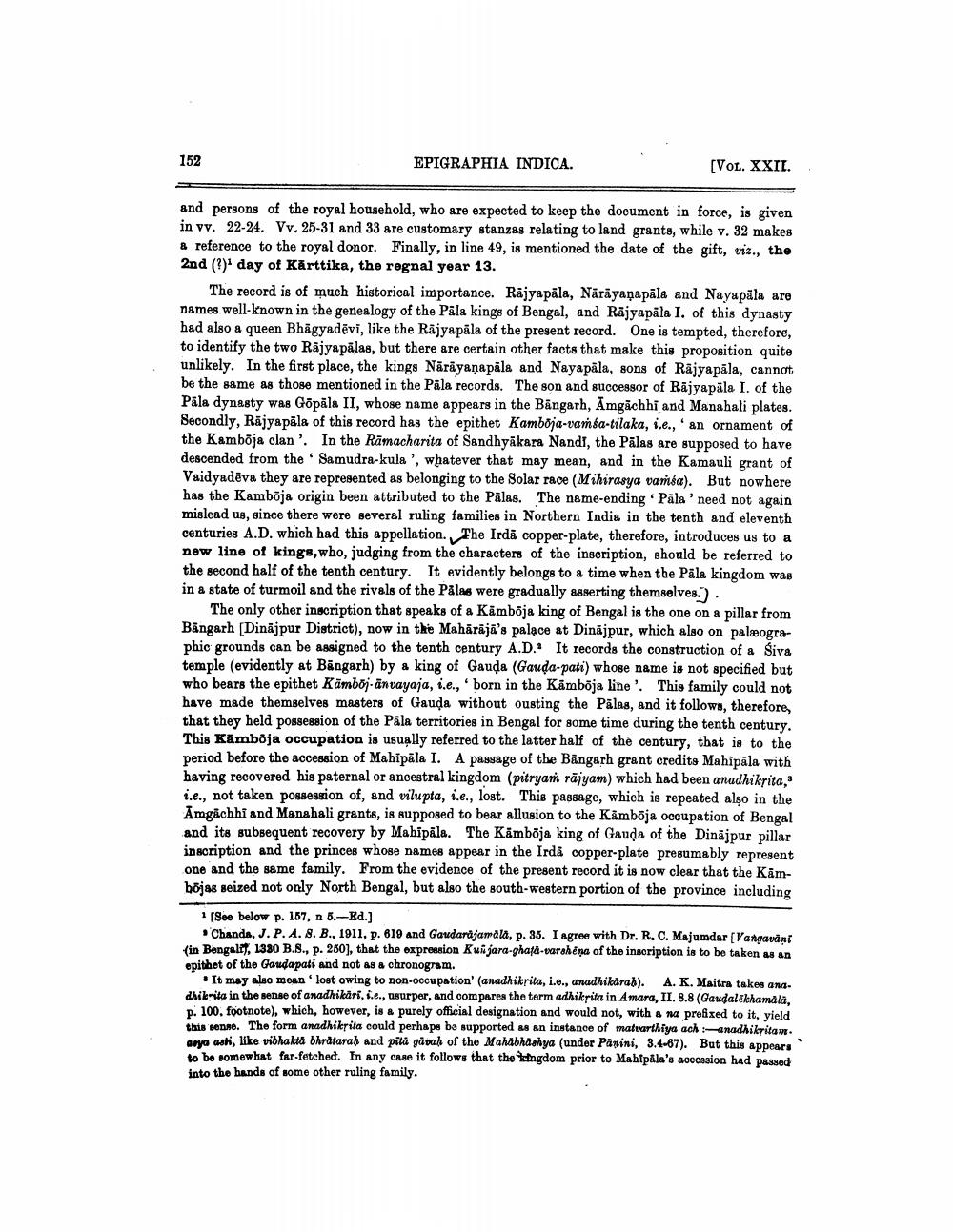________________
152
EPIGRAPHIA INDICA.
(VOL. XXII.
and persons of the royal household, who are expected to keep the document in force, is given in vv. 22-24. Vv. 25-31 and 33 are customary stanzas relating to land grants, while v. 32 makes & reference to the royal donor. Finally, in line 49, is mentioned the date of the gift, viz., the 2nd (?)' day of Kārttika, the regnal year 13.
The record is of much historical importance. Räjyapāla, Nārāyaṇapāla and Nayapāla are names well-known in the genealogy of the Pāla kings of Bengal, and Rajyapāla I. of this dynasty had also a queen Bhāgyadēvi, like the Rājyapāla of the present record. One is tempted, therefore, to identify the two Rajyapālas, but there are certain other facts that make this proposition quite unlikely. In the first place, the kings Nārāyaṇapāla and Nayapāla, sons of Rajyapāla, cannot be the same as those mentioned in the Pala records. The son and successor of Rajyapāla I. of the Pāla dynasty was Gopāla II, whose name appears in the Bangarh, Āmgachhi and Manahali plates. Secondly, Räjyapāla of this record has the epithet Kamboja-vamsa-tilaka, i.e., ' an ornament of the Kamboja clan'. In the Ramacharita of Sandhyākara Nandi, the Pālas are supposed to have descended from the Samudra-kula ', whatever that may mean, and in the Kamauli grant of Vaidyadēva they are represented as belonging to the Solar race (Mihirasya varsa). But nowhere has the Kamboja origin been attributed to the Pālas. The name-ending Päla' need not again mislead us, since there were several ruling families in Northern India in the tenth and eleventh centuries A.D. which had this appellation. The Indă copper-plate, therefore, introduces us to a new line of kings,who, judging from the characters of the inscription, should be referred to the second half of the tenth century. It evidently belongs to a time when the Pāla kingdom was in a state of turmoil and the rivals of the Palas were gradually asserting themselves.).
The only other inscription that speaks of a Kamboja king of Bengal is the one on a pillar from Băngarh Dinajpur District), now in the Mahārajā's palace at Dinājpur, which also on palæographic grounds can be assigned to the tenth century A.D.' It records the construction of a Siva temple (evidently at Bangarh) by & king of Gauda (Gauda-pati) whose name is not specified but who bears the epithet Kāmboj-anvayaja, i.e., born in the Kamboja line'. This family could not have made themselves masters of Gauda without ousting the Pālas, and it follows, therefore, that they held possession of the Pāla territories in Bengal for some time during the tenth century. This Kāmboja occupation is usually referred to the latter half of the century, that is to the period before the accession of Mahipala I. A passage of the Bangarh grant credits Mahipāla with having recovered his paternal or ancestral kingdom (pitryan rājyam) which had been anadhiksita, i.e., not taken possession of, and vilupta, i.e., lost. This passage, which is repeated also in the Amgachhi and Manahali grants, is supposed to bear allusion to the Kåmboja occupation of Bengal and its subsequent recovery by Mahipāla. The Kämbõja king of Gauda of the Dinajpur pillar inscription and the princes whose names appear in the Irdã copper-plate presumably represent one and the same family. From the evidence of the present record it is now clear that the Kämbojas seized not only North Bengal, but also the south-western portion of the province including
1 [See below p. 187, n 5.-Ed.)
Chands, J.P. A. 8. B., 1911, p. 619 and Gaudardjamala, p. 36. I agree with Dr. R. C. Majumdar (Vangaudai (in Bengalit, 1330 B.S., p. 250], that the expression Kuijara-ghafa varahina of the inscription is to be taken as an epithet of the Gaudapati and not as a chronogram.
It may also mon lost owing to non-occupation' (anadhikrita, i.e., anadhikarab). A. K. Maitra takes ang. dhikrita in the sense of anadhikari, i.e., turper, and compares the term adhikrita in Amara, II. 8.8 (Gaudalekhamala. p. 100.footnote), which, however, is a purely official designation and would not, with a na prefixed to it, yield this sense. The form anadhikrita could perhaps be supported as an instance of matvarthiya ach -anadhikritam. arva asti, like vibhakta bhratarah and pita gåvah of the Mahabhashya (under Panini, 3.4-87). But this appears to be somewhat far-fetched. In any case it follows that the kingdom prior to Mahipala's accession had passed into the hands of some other ruling family,




